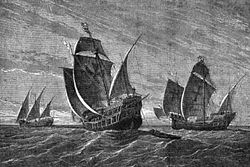Niña
 A proposed depiction of the Niña, the carrack on the right | |
| Career (Spain) | |
|---|---|
| Name: | Santa Clara |
| Owner: | Juan Niño |
| General characteristics | |
| Class and type: | Caravel |
The Niña (the Spanish word for "girl") was one of the three ships used by Christopher Columbus in his first voyage towards the Indies in 1492. The real name of the Niña was Santa Clara. The name Niña was probably a pun on the name of her owner, Juan Niño of Moguer. She was a caravel-type vessel.
The other ships of the Columbus expedition were the caravel-type Pinta and the carrack-type Santa María. The Niña was by far Columbus' favorite. She was originally lateen sail rigged caravela latina, but she was re-rigged as caravela redonda at Azores with square sails for better ocean performance. There is no authentic documentation on the specifics of the Niña's design. Often said to have had three masts, there is some evidence she may have had four masts.[1]
History
On Columbus' first expedition, the Niña carried 24 men, captained by Vicente Yáñez Pinzón. They left Palos de la Frontera on August 3, 1492, stopping at the Canary Islands on August 12, 1492, and continued westward. Landfall was made in the Bahamas at dawn on October 12, 1492. After one of his men accidentally ran the Santa Maria aground, Columbus returned on the Niña in early 1493. On 14 February, in the east of the Azores, a storm threatened to capsize the Niña, and, at Columbus's instigation, he and the crew took a series of vows to perform certain acts, including pilgrimages, upon their return to Spain.[2] The Niña reached Lisbon, Portugal on March 4[3] and arrived in Palos de la Frontera on March 15. On the first voyage to America the crew of the Niña slept on the deck, but adopted the use of hammocks after seeing Native Americans sleeping in hammocks.[1]
The Niña joined a grand fleet of 17 ships for the second voyage to Hispaniola, becoming the flagship for an exploration of Cuba. She was the only ship to survive the 1495 hurricane, returning quickly to Spain in 1496.
The Niña was then chartered for an unauthorized voyage to Rome. She was captured by a pirate corsair when leaving the port of Cagliari and brought to Cape Pula, Sardinia. The Captain, Alonso Medel, escaped with a few men. He stole a boat, rowed back to Niña, and made sail, returning to Cadiz.
In 1498 she returned to Hispaniola as advance guard of Columbus' Third Voyage. She was lying in wait at Santo Domingo in 1500. In 1501 she made a trading voyage to the Pearl Coast and there is no further log of her.
The Niña logged at least 25,000 nautical miles (46,000 km) under Columbus' command.
Replica
A replica of the Niña (based upon theory; there are no known contemporary likenesses of any of the three ships) now sails around the world.
The 4-masted replica Niña was built in 1988 by engineer and naval researcher John Patrick Sarsfield, British naval historian Jonathan Morton Nance, and a group of master shipbuilders in Bahia, Brazil who were still using design and construction techniques dating back to the 15th century. They built it from heavy, teredo-resistant Brazilian hardwoods using only adzes, axes, hand saws, and chisels. The sails were designed by Nance using square main sails and two aft lateen sails as were used by ships of this size at the end of the 15th century. The crew of the Niña say that it can make about 5-7 knots, which is quicker than older designs of the era. The replica weighs 75 tons.
In 1991, the replica sailed to Costa Rica to take part in the filming of "1492: Conquest of Paradise",[4] and the Niña has visited hundreds of North America ports to give the public a chance to see and tour the ship. It now sits at a boatyard in Corpus Christi, Texas and is owned by the city. The Columbus Sailors Association is currently seeking to purchase the ships so as to restore them.
See also
References
- ↑ 1.0 1.1 The Story of the Niña, TheNina.com - Official site of the replica ship
- ↑ Christopher Columbus and Bartolomé de las Casas, Samuel Kettell (translator), Personal narrative of the first voyage of Columbus to America: From a manuscript recently discovered in Spain, T. B. Wait and Son, 1827. p. 216. Online at Google Books. A version in modern Spanish—Text for 11-16 February—can be accessed online at artehistoria.jcyl.es.
- ↑ Fernández Duro, Cesáreo (1892). Pinzón en el descubrimiento de las Indias. Madrid: Sucesores de Rivadeneyra. p. 113. http://www.archive.org/stream/pinzbonenel00fernrich#page/n3/mode/2up.
- ↑ "The Niña". Niña Traveling Museum. http://www.thenina.com. Retrieved 2008-05-10.
External links
| Niña (ship)
]]ast:La Niña (carabela) ca:La Niña (caravel·la) da:Niña de:Niña es:La Niña (carabela) eu:La Niña (itsasontzia) fr:La Niña (navire) fur:Niña it:Niña nl:Niña ja:ニーニャ号 no:«Niña» nds:Niña pl:Niña pt:Niña ru:Нинья simple:Niña sr:Ниња sh:Niña fi:Niña zh:尼尼亚号

